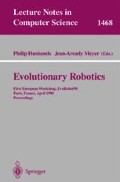Abstract
This paper describes a new approach for promoting the evolution of relatively complex behaviours in evolutionary robotics, based on the use of noise in simulation. A ‘homing navigation’ behaviour is evolved (in simulation) for the Khepera mobile robot, and it is shown that high noise levels in the simulation promote the evolution of relatively complex behavioural and neural dynamics. It is also demonstrated that simulation noise can actually accelerate artificial evolution.
Preview
Unable to display preview. Download preview PDF.
References
J.M. Baldwin. A new factor in evolution. American Naturalist, 30:441–451, 1896.
D. Floreano and F. Mondada. Evolution of homing navigation in a real mobile robot. IEEE transactions on systems, man, and cybernetics: part B; cybernetics, 26(3):396–407, 1996.
G.E. Hinton and S.J. Nowlan. How learning can guide evolution. Complex Systems, 1:495–502, 1987.
N. Jakobi, Evolutionary robotics and the radical envelope of noise hypothesis. Journal of Adaptive Behaviour, 6 (2), 1997. (forthcoming).
N. Jakobi. Half-baked, ad-hoc and noisy: Minimal simulations for evolutionary robotics. In P. Husbands and I. Harvey, editors, Proceedings of the 4th European Conference on Artificial Life, pages 348–357. MIT Press, 1997.
N. Jakobi, P. Husbands, and I. Harvey. Noise and the reality gap: the use of simulation in evolutionary robotics. In F. Moran, A. Moreno, J. Merelo, and P. Chicon, editors, Advances in Artificial Life: Proc. 3rd European Conference on Artificial Life. Springer-Verlag, 1995.
K-Team. Khepera: the user's manual. Technical report, LAMI-EPFL, 1993.
O. Miglino, H.H. Lund, and S. Nolfi. Evolving mobile robots in simulated and real environments. Artificial Life, 2(4):417–434, 1996.
S. Nolfi. Evolving non-trivial behaviours on real robots: a garbage collecting robot. Technical Report 96–04, Institute of psychology, NRC, Rome, Italy, 1996.
A.K. Seth. Interaction, uncertainty, and the evolution of complexity. In P. Husbands and I. Harvey, editors, Proceedings of the 4th European Conference on Artificial Life, pages 521–530. MIT Press, 1997.
K. Sims. Evolving 3d morphology and behaviour by competition. In Proceedings of Alife IV, pages 28–39. MIT Press, Cambridge, Mass., 1994.
Author information
Authors and Affiliations
Editor information
Rights and permissions
Copyright information
© 1998 Springer-Verlag Berlin Heidelberg
About this paper
Cite this paper
Seth, A.K. (1998). Noise and the pursuit of complexity: A study in evolutionary robotics. In: Husbands, P., Meyer, JA. (eds) Evolutionary Robotics. EvoRobots 1998. Lecture Notes in Computer Science, vol 1468. Springer, Berlin, Heidelberg. https://doi.org/10.1007/3-540-64957-3_68
Download citation
DOI: https://doi.org/10.1007/3-540-64957-3_68
Published:
Publisher Name: Springer, Berlin, Heidelberg
Print ISBN: 978-3-540-64957-1
Online ISBN: 978-3-540-49902-2
eBook Packages: Springer Book Archive

